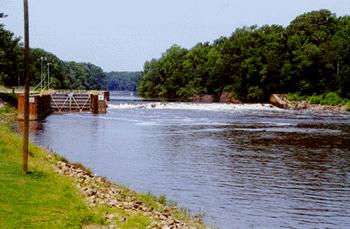
RALEIGH, N.C. – The removal of three obsolete dams in North Carolina could improve recreational and commercial fisheries for striped bass, American shad, hickory shad, and help tremendously in restoration efforts for river herring, Atlantic sturgeon and shortnose sturgeon. The demolition of locks and dams No. 1, No. 2 and No. 3 along the Cape Fear River would restore very important spawning and nursery habitat for these migratory fish in the river, and increases in their populations would likely result, according to the N.C. Wildlife Resources Commission, N.C. Division of Marine Fisheries, U.S. Fish and Wildlife Service and the National Marine Fisheries Service.
If recovery of the striped bass, American shad and hickory shad populations happened as predicted, recreational and commercial fisheries for these fish would improve. Coastal marine fisheries would benefit also because juvenile shad and herring spawned in fresh waters migrate downstream to the ocean and provide an important prey base for other popular fish species, such as red drum, flounder, bluefish and seatrout.
“The combined effects of increased shad and striped bass populations along with the benefits of an increase forage base for other game fish could potentially generate millions of dollars annually to North Carolina’s economy,” said Mike Wicker of the U.S. Fish and Wildlife Service. “River herring and sturgeon, species that are at all time record low numbers, would greatly benefit by once again having access to their historic spawning and nursery area habitats.”
Nationwide, removal of old and non-functioning dams from rivers and waterways is a growing trend. Many small dams that once provided water power to turn grist mills or saw blades now serve no useful function but block migratory fish from their historic spawning and nursery areas.
In North Carolina, the removal in 1998 of Quaker Neck Dam on the Neuse River near Raleigh resulted in migratory striped bass and American shad being able to reach their former spawning grounds. Since removal of Quaker Neck Dam, other smaller dams on Little River, a tributary of Neuse River, have reopened many more miles of spawning habitat as well.
The U.S. Army Corps of Engineers owns and operates Lock and Dams No. 1, No. 2 and No. 3 on the Cape Fear River, and these structures are no longer used for navigation, which was their intended purpose. The Corps is interested in “decommissioning” the dams and is currently studying their options as part of a General Reevaluation Report for the Wilmington Harbor Deepening Project.
Although the Cape Fear River locks and dams were not designed for water supply, Wilmington, Fayetteville and other local users depend on impounded waters behind these dams for their water supply source. The fishery agencies are committed to working in partnership with these water users and other agencies to find water supply solutions that will satisfy municipal water needs before any of the three Cape Fear River lock and dams are removed.
State and federal fishery agencies promoting removal of these dams are anxious to work collaboratively with municipalities and citizen groups to restore fisheries habitat in North Carolina’s coastal rivers.
“The benefits of restoring healthy fish populations in the state’s rivers and streams go far beyond the enjoyment of just catching a fish,” said Bob Curry, chief of the Wildlife Resources Commission’s Division of Inland Fisheries. “They extend to our economy, to our culture and to our dedication to conserving our rich heritage of natural resources.”



